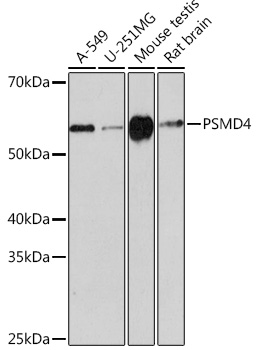Anti-PSMD4 Antibody (CAB3663)
- SKU:
- CAB3663
- Product type:
- Antibody
- Reactivity:
- Human
- Reactivity:
- Mouse
- Reactivity:
- Rat
- Host Species:
- Rabbit
- Isotype:
- IgG
- Research Area:
- Cell Biology
Description
| 抗体名: | Anti-PSMD4 Antibody |
| 抗体コード: | CAB3663 |
| 抗体サイズ: | 20uL, 50uL, 100uL |
| 申し込み: | WB IF |
| 反応性: | Human, Mouse, Rat |
| 宿主種: | Rabbit |
| 免疫原: | A synthesized peptide derived from human PSMD4 |
| 申し込み: | WB IF |
| 推奨希釈: | WB 1:500 - 1:2000 IF 1:50 - 1:200 |
| 反応性: | Human, Mouse, Rat |
| ポジティブサンプル: | A-549, U-251MG, Mouse testis, Rat brain |
| 免疫原: | A synthesized peptide derived from human PSMD4 |
| 精製方法: | Affinity purification |
| ストレージバッファ: | Store at -20'C. Avoid freeze / thaw cycles. Buffer: PBS with 0.02% sodium azide, 0.05% BSA, 50% glycerol, pH7.3. |
| アイソタイプ: | IgG |
| 順序: | Email for sequence |
| 遺伝子ID: | 5710 |
| Uniprot: | P55036 |
| セルラーロケーション: | |
| 計算された分子量: | 50kDa |
| 観察された分子量: | 55KDa |
| 同義語: | AF, AF-1, ASF, MCB1, Rpn10, S5A, pUB-R5 |
| バックグラウンド: | The 26S proteasome is a multicatalytic proteinase complex with a highly ordered structure composed of 2 complexes, a 20S core and a 19S regulator. The 20S core is composed of 4 rings of 28 non-identical subunits; 2 rings are composed of 7 alpha subunits and 2 rings are composed of 7 beta subunits. The 19S regulator is composed of a base, which contains 6 ATPase subunits and 2 non-ATPase subunits, and a lid, which contains up to 10 non-ATPase subunits. Proteasomes are distributed throughout eukaryotic cells at a high concentration and cleave peptides in an ATP/ubiquitin-dependent process in a non-lysosomal pathway. An essential function of a modified proteasome, the immunoproteasome, is the processing of class I MHC peptides. This gene encodes one of the non-ATPase subunits of the 19S regulator lid. Pseudogenes have been identified on chromosomes 10 and 21. [provided by RefSeq, Jul 2008] |
| UniProt Protein Function: | PSMD4: Binds and presumably selects ubiquitin-conjugates for destruction. Displays selectivity for longer polyubiquitin chains. Modulates intestinal fluid secretion. The 26S proteasome is composed of a core protease, known as the 20S proteasome, capped at one or both ends by the 19S regulatory complex (RC). The RC is composed of at least 18 different subunits in two subcomplexes, the base and the lid, which form the portions proximal and distal to the 20S proteolytic core, respectively. Directly interacts with NUB1. Interacts with SQSTM1. Interacts with UBQLN4. Belongs to the proteasome subunit S5A family. 2 isoforms of the human protein are produced by alternative splicing. |
| UniProt Protein Details: | Protein type:Protease; Proteasome complex Chromosomal Location of Human Ortholog: 1q21.3 Cellular Component: proteasome complex; nucleoplasm; cytoplasm; cytosol Molecular Function:identical protein binding; protein binding Biological Process: positive regulation of ubiquitin-protein ligase activity during mitotic cell cycle; negative regulation of ubiquitin-protein ligase activity during mitotic cell cycle; protein polyubiquitination; viral reproduction; apoptosis; antigen processing and presentation of exogenous peptide antigen via MHC class I, TAP-dependent; DNA damage response, signal transduction by p53 class mediator resulting in cell cycle arrest; regulation of apoptosis; antigen processing and presentation of peptide antigen via MHC class I; regulation of ubiquitin-protein ligase activity during mitotic cell cycle; anaphase-promoting complex-dependent proteasomal ubiquitin-dependent protein catabolic process; antigen processing and presentation of exogenous peptide antigen via MHC class I; gene expression; mitotic cell cycle; regulation of amino acid metabolic process; negative regulation of apoptosis; G1/S transition of mitotic cell cycle |
| NCBI Summary: | The 26S proteasome is a multicatalytic proteinase complex with a highly ordered structure composed of 2 complexes, a 20S core and a 19S regulator. The 20S core is composed of 4 rings of 28 non-identical subunits; 2 rings are composed of 7 alpha subunits and 2 rings are composed of 7 beta subunits. The 19S regulator is composed of a base, which contains 6 ATPase subunits and 2 non-ATPase subunits, and a lid, which contains up to 10 non-ATPase subunits. Proteasomes are distributed throughout eukaryotic cells at a high concentration and cleave peptides in an ATP/ubiquitin-dependent process in a non-lysosomal pathway. An essential function of a modified proteasome, the immunoproteasome, is the processing of class I MHC peptides. This gene encodes one of the non-ATPase subunits of the 19S regulator lid. Pseudogenes have been identified on chromosomes 10 and 21. [provided by RefSeq, Jul 2008] |
| UniProt Code: | P55036 |
| NCBI GenInfo Identifier: | 1709796 |
| NCBI Gene ID: | 5710 |
| NCBI Accession: | P55036.1 |
| UniProt Secondary Accession: | P55036,Q5VWC5, Q9NS92, D3DV16, |
| UniProt Related Accession: | P55036 |
| Molecular Weight: | 377 |
| NCBI Full Name: | 26S proteasome non-ATPase regulatory subunit 4 |
| NCBI Synonym Full Names: | proteasome (prosome, macropain) 26S subunit, non-ATPase, 4 |
| NCBI Official Symbol: | PSMD4 |
| NCBI Official Synonym Symbols: | AF; ASF; S5A; AF-1; MCB1; Rpn10; pUB-R5 |
| NCBI Protein Information: | 26S proteasome non-ATPase regulatory subunit 4; angiocidin; antisecretory factor 1; S5a/antisecretory factor protein; multiubiquitin chain-binding protein; 26S proteasome regulatory subunit S5A |
| UniProt Protein Name: | 26S proteasome non-ATPase regulatory subunit 4 |
| UniProt Synonym Protein Names: | 26S proteasome regulatory subunit RPN10; 26S proteasome regulatory subunit S5A; Antisecretory factor 1; AF; ASF; Multiubiquitin chain-binding protein |
| Protein Family: | 26S proteasome non-ATPase regulatory |
| UniProt Gene Name: | PSMD4 |
| UniProt Entry Name: | PSMD4_HUMAN |


